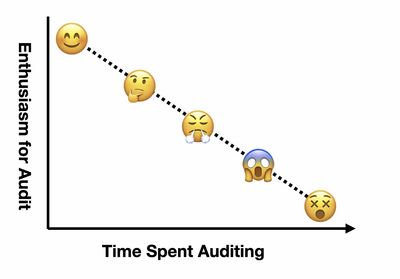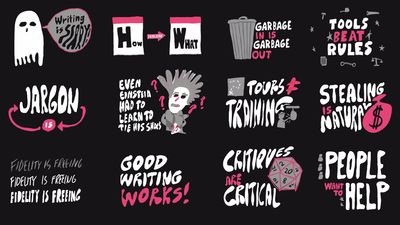Plain Language Summit 2020 - Day 2
These are the day 2 talks I could attend. I couldn’t make it on Day 1 because it was Health Order Update Day. (Those in COVID response know... 😬)
But you can look at the slides and videos yourself on Digital.gov’s webpage about the event!
Motivate and mobilize people for change with Bethany Blakey
Original thread on Twitter
Got my coffee ☕️ and I’m READY for an early (for the west coast) 3rd session with Bethany Blakey on motivating and mobilizing people with plain language. TL;DR, it’s about STORY, of course!
“Make it easier for your audience to make the choice.” Nudge them, although definitely only use this for good!
The Post-Its I have on my monitor while doing COVID response work:
- BLUF (Bottom Line Up Front)
- Explain
- Options/Tradeoffs
- Acknowledge ❤️ and 😱

Content strategy (vs tactics) with Ginny Redish
Original thread on Twitter
Doing an audit is not strategy. You can only properly do an audit if you have a strategy! “You have to know what you’re trying to achieve.”
Turning legalese into plain language is not the win. The win is when you help your users achieve their goals. 🙌
Sensemaking lessons from the private sector with Abby Covert
Original thread on Twitter
Lean into complexity—the superpower of IAs and the plain language community is by managing complexity! Detective work is needed.🕵🏻♀️ Understand all the contexts.
“Where there are people, there is complexity.” Too real! (If you don’t get that, you might be stuck in a revision spiral, or worse, miss opportunities and waste efforts!)
Interview your stakeholders! Set boundaries—let them know what’s expected (talk about their experience, keep things in confidence). Lean on a script as a goalpost. Plan a question flow to build trust.
Trust-building flow:
- Position: Questions that explore the stakeholders’ position in relation to the subject being explored in the interview.
- Beliefs: Questions that push to explore the things the stakeholder believes to be true as it relates to the subject being explored.
- Doubts: Questions that push the stakeholder to explore the things that make them less comfortable in the subject being explored.
- Color: Questions that you feel they are uniquely positioned to answer given their background, experience, and/or answers to the above.
I thought I already had a pretty good idea of what kind of people (i.e., people who “hold a stake”) to talk to, but Abby has a list, of course! Listen and take your own notes, transcripts not enough. It will take time, 3x as much as you think just to interview.
Find the people who:
- Could change the course of your project mid-stream
- Sign off on your work or the work of your partners
- Will help you make the thing you are making
- Market the thing you are making
- Measure the success of the thing you are making
- Maintain the thing you are making
- Translate/interpret/adapt the thing you are making
- Provide customer service on the thing you are making
Make sure people are working from the same maps. Get everyone together to create one together.
Since people equal complexity, you also have to document the bounds of the problem space. What can you control, influence, or consider risks of?
“Spreadsheets are my love language.” (Saaaame!)

Abby points out that in sensemaking, it’s people all the way down! Be kind and brave—always ask a question. You’ll always learn a lot, even if you think you know! And make sure to define what “enough” is, and defend it.
Always pay it forward. “Be clarity for those drowning in ambiguity.” Make the world a better place! 😄
Oops, “it depends” often comes across as “there is no hope” to our stakeholders! Say “goodbye confusion” (Japanese translation of “Make Sense of Any Mess”) instead of adding to it!
Q&A time! Doing all your stakeholder interviews and THEN facilitating a workshop with everyone means you (as the facilitator) see all the contradictions and understand the context.
And of course Abby already has her talk script online.
How smart teams create and train writers by Scott Kubie
Original thread on Twitter
Scott Kubie begins his session by reminding us that “there’s more to writing than just writing.” Tips from his 12 years of teaching writing, here we go!
Remember that writing is scary! Lots of people have bad memories of it from school. We have to unlearn that.
The “how” to write precedes the “what” to write. People need guidance about the mechanics of writing a certain type of content, so they know where to start.
Scott’s framework for writing:
- Prepare (set goals)
- Compose (“the writing”)
- Edit (put on a different hat for this)
- Finish (QA, legal review, adding links, what’s going to happen after they draft)
Garbage in is garbage out. (For real. SF.gov’s COVID content makes sense because the public health guidance makes sense! I can’t make 💩 not-💩!)
Tools beat rules. Rules are good and fine, but how are you helping people apply it to their writing? (Make it easy for people to do the right thing, and hard to do the wrong thing!)
Jargon is jargon! (Including “plain language.” Explain what you mean!)
A tip for training writing to subject matter experts: Even Einstein had to learn to tie his shoes! As a power user, you may be using tools that not everyone knows about. Share tips that people might find helpful, even maybe (gasp!) fun!
Tours are not the same as training! Just showing people where stuff is not nearly enough. Look as far ahead as you need to, book some actual trainings for people.
To help people start writing, Scott reminds us that “stealing is natural.” Even for yourself—helps in the preparation step! Although it’s yet another fear we have to unlearn from school! Most writing for government, business, UX, etc, don’t need to be original.
Fidelity is freeing. Make it clear if someone is working with “low fidelity” text (i.e. first drafts) and incorporate the culture that writing takes work. Can use colors or fonts (yup, Comic Sans!).
Remind people that “good writing works.” Avoid an unbalanced focus on grammar perfection. Get it out and helping people ASAP!
Crits are critical. Talk about content goals, then workshop it together. That’s a massive training and educational opportunity! Scott says he leaves 1 hour per week for content crits. (I admittedly don’t do this enough because COVID content is ASAP! 🙁)
Remember that people want to help! Gatekeeping means missed opportunities for trust and learning.

LOL Scott drops a “I like FAQs” zinger right before his session ends! 😂
